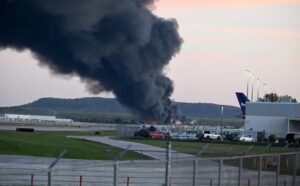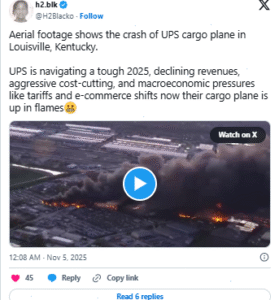UPS Cargo Plane Disaster Outside Louisville: What We Know So Far

On the evening of Tuesday, November 4, 2025, tragedy struck the skies above Louisville, Kentucky. A cargo jet operated by United Parcel Service (UPS) crashed moments after take-off from Louisville Muhammad Ali International Airport, igniting a blaze, scattering debris across a wide zone, and sending shockwaves through the city, its industrial belt, and the national aviation community.
The aircraft in question: Flight 2976, a 34-year-old McDonnell Douglas MD-11F freighter, bound for Honolulu’s Daniel K. Inouye International Airport in Hawaii. Al Jazeera+3Wikipedia+3WLWT+3 In official statements, the Federal Aviation Administration (FAA) confirmed the crash occurred at approximately 5:15 p.m. local time shortly after departure. KTVZ+2FOX 5 Atlanta+2
A Flight That Turned Catastrophic — Fast
What began as a routine Tuesday evening air-cargo departure quickly twisted into disaster. According to early accounts, the jet showed signs of trouble almost immediately after take-off — including a large fireball, engine separation, and rapid descent. Al Jazeera+2ABC News+2
One of the most alarming revelations: Investigators say the left engine of the aircraft detached from the wing just seconds into flight. Reuters+1 Aerial footage later revealed a wide debris field, charred vehicles, destroyed buildings, and the plane’s wreckage strewn across an industrial lot near the airport. WDRB+1

The Human Toll & Immediate Response
Within hours, Louisville Mayor Craig Greenberg and Kentucky Governor Andy Beshear were on site issuing urgent statements. “Please, pray for the families affected … we are hurting right now after a heartbreaking day,” Beshear said, urging caution over possible environmental hazards from fuel or cargo.
Initial reports cited at least seven fatalities and more than 11 injuries — but officials cautioned the numbers were likely to rise as search and recovery continued. AP News+1 By Thursday, the death toll had climbed to 13 confirmed — including both crew and ground casualties. The Guardian+1
Emergency services mobilized fast and at scale: dozens of fire departments, the Kentucky National Guard, multiple police agencies, and industrial response teams raced to the scene to battle fire, control hazards, and begin victim recovery — all complicated by the volume of fuel on board and the scale of destruction.
Industrial Zone Hit — Shelter-In-Place Issued
The crash zone included two nearby businesses and an auto-parts yard, introducing a ground-level casualty and grief component that extended beyond the flight crew. Grade A Auto Parts reported employees missing; Kentucky Petroleum Recycling suffered damage to infrastructure. AP News+1
Because the freighter was fully fuelled for the long haul to Hawaii, the blast was massive. Witnesses described explosions, a fireball consuming vehicles, and black smoke descending on the neighborhood near the runway. CBS News+1 Residents and workers in a wide radius were ordered to shelter-in-place as investigators declared the site an active hazard area. LEX 18 News – Lexington, KY (WLEX)

The Investigation Begins — FAA & NTSB Lead
The FAA rapidly confirmed that its partner, the National Transportation Safety Board (NTSB), will lead the formal investigation. X (formerly Twitter)+1 Early information pointed to the engine detachment and wing fire, with a focus on the aircraft’s maintenance and structural history. The MD-11 in question had recently undergone a major maintenance period in San Antonio, Texas. The Guardian+1
In a briefing, NTSB board member Todd Inman noted that the cockpit voice recorder captured a repeating warning bell 37 seconds after take-off thrust was applied, and that the crew attempted control for about 25 seconds before impact. Reuters Investigators emphasized the preliminary nature of the data and stressed that conclusions would follow only after careful analysis of all components.
What’s Known — and What Remains Unclear
Known facts include:
-
Flight 2976 crashed near the end of the runway shortly after take-off at 5:15 p.m. https://www.hawaiinewsnow.com
-
The MD-11’s left engine separated, creating initial catastrophic damage and fire. The Guardian+1
-
Debris and damage extended into nearby properties and industrial space. WDRB
-
At least 13 people were killed by the crash and explosion, including crew and people on the ground. CBS News
Still under investigation:
-
The exact chain of mechanical failures (engine, wing structure, systems) that precipitated the detachment.
-
Whether maintenance history or structural fatigue played a role.
-
The role of the large fuel load in magnifying the damage and fire spread.
-
The full identity and condition of ground-victims, including potential missing persons still unaccounted for.

The Broader Impact & Industry Reflections
Beyond the immediate human tragedy, the crash hits deep for Louisville and UPS. The city hosts UPS’s major air-cargo hub, processing millions of packages and employing thousands. Operations at the hub were briefly suspended. CBS News
Aviation experts note that take-off and landing phases are among the most perilous in any flight. A freighter fully fuelled and laden for a long trans-Pacific route presents heightened risk in these critical moments. WCVB
For the local community, it’s a moment of loss and reckoning — workers, residents, first responders, and families are left to pick up the pieces. In the words of one witness: “It makes you stop and think.” WDRB
What Comes Next
In the hours and days ahead:
-
The search and recovery zone will remain active. Debris will be catalogued. Victim identification and family support continue.
-
The NTSB will issue a preliminary report within about 30 days, with a full probable-cause report expected much later. Reuters
-
UPS and aviation regulators will review safety protocols, maintenance records, and aircraft-fleet status.
-
The city of Louisville will assess recovery needs, environmental impact, business losses, and community support requirements.
-
Flights and cargo operations at the airport and the UPS hub will resume gradually under heightened scrutiny.

Conclusion
In a blink, a routine cargo departure turned into one of the worst aviation disasters in recent U.S. freight-flight history. The crash of UPS Flight 2976 near Louisville is still fresh. The stories of those lost, the courage of the first responders, the scale of destruction and the weight of unanswered questions are all now part of this city’s narrative.
As investigators dig in, families mourn, and the community rallies, one thing stands out: this tragedy will linger long after the last piece of metal is cleared and the final report published. The heart of Louisville, its people, its air-field, and its cargo-hub, have been irrevocably changed.